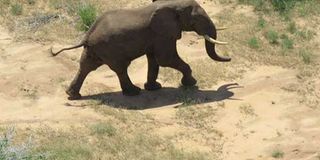KWS to use collared elephants to monitor effect of standard gauge railway on wildlife

An elephant that was fitted with a tracking collar in Kenya's coastal Tana River delta. The Kenya Wildlife Service has begun collaring elephants in the Tsavo National Park so as to monitor how the new standard gauge railway line affects their lives. AFP PHOTO | SAVE THE ELEPHANTS | NATION MEDIA GROUP
What you need to know:
- The collared elephants will provide an enhanced understanding of connectivity in the Tsavo ecosystem, which will in turn influence future infrastructural planning.
- The four-day exercise that starts Tuesday seeks to understand how elephant movements will be influenced by the elevated sections of the railway within the Tsavo conservation area.
- Originally, the SGR was to run parallel to the old line, and on the fringes of the park.
- Conservationists unsuccessfully went up in arms against the realignment of the line to pass through the national park.
The Kenya Wildlife Service has begun collaring elephants in the Tsavo National Park so as to monitor how the new standard gauge railway (SGR) line affects their lives.
The project, undertaken with technical and logistical support from Save the Elephants (STE), will involve fitting 10 jumbos near the SGR in the Tsavo ecosystem with advanced satellite radio tracking collars.
Elephants from both sides of the park will be collared to scientifically monitor how they adapt to the railway.
The operation will be done mainly through aerial teams, with a KWS helicopter leading the darting operation, backed by KWS veterinary and capture staff and STE collaring specialists.
The four-day exercise that starts Tuesday seeks to understand how elephant movements will be influenced by the elevated sections of the railway within the Tsavo conservation area.
At least 133 kilometres of the 483km/h high-speed train passing through the conservation area is being raised above the normal terrain levels and fenced off.
PARK CUT INTO TWO
STE experts said the effect of this is that the largest national park in Kenya, home to the largest population of elephants, will be cut into two, making wildlife mobility dependent on the wildlife crossing structures put in place.
“This project is the first of its kind in Kenya and indeed in Africa. Beyond basic land-use planning, it seeks to understand how elephant movements are influenced by a major infrastructural project.
“It is an excellent precursor for future planning in wildlife-rich areas where development is set to take place, such as on the Lapsset corridor in northern Kenya,” said Dr Benson Okita, STE’s head of monitoring.
The wildlife conservationist said by generating detailed maps showing the intensity of use of the wildlife crossing structures, the collared elephants will provide an enhanced understanding of connectivity in the Tsavo ecosystem, which will in turn influence future infrastructural planning.
“As the use of elephant movement data to inform the planning process is refined, more precise spatial definition will allow the country to proactively secure space for wildlife as the Kenyan population grows,” said Patrick Omondi, KWS deputy director of species conservation and management.
Originally, the SGR was to run parallel to the old line, and on the fringes of the park.
Conservationists unsuccessfully went up in arms against the realignment of the line to pass through the national park instead of the initial route in which it would have displaced high-value properties that the government estimated would have cost billions of shillings in compensation payments.





